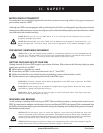
8
www.pridemobility.com Hurricane
II. SAFETY
PRE-RIDE SAFETY CHECK
Get to know the feel of your PMV and its capabilities. Pride recommends that you perform a safety check before
each use to make sure your PMV operates smoothly and safely. For details on how to perform these necessary
inspections, see XI. “Care and Maintenance.”
Perform the following inspections prior to using your PMV:
! Check for proper tire inflation (if equipped with pneumatic tires).
! Check all electrical connections. Make sure they are tight and not corroded.
! Check all harness connections. Make sure they are secured properly.
! Check the brakes.
! Check battery charge.
If you discover a problem, contact your authorized Pride Provider for assistance.
TIRE INFLATION
If your PMV is equipped with pneumatic tires, you should check or have the air pressure checked at least once a
week. Proper inflation pressures will prolong the life of your tires and help ensure the smooth operation of your
PMV.
WARNING! It is critically important that 30-35 psi tire pressure be maintained in pneumatic
tires at all times. Do not underinflate or overinflate your tires. Low pressure may result in
loss of control, and overinflated tires may burst. Failure to maintain 30-35 psi tire pressure
in pneumatic tires at all times may result in tire and/or wheel failure, causing serious
personal injury and/or damage to your PMV.
WARNING! Inflate your PMV tires from a regulated air source with an available pressure
gauge. Inflating your tires from an unregulated air source could overinflate them, resulting
in a burst tire and/or personal injury.
WEIGHT LIMITATIONS
Your PMV is rated for a maximum weight capacity. Refer to the specifications table for information.
WARNING! Exceeding the weight capacity voids your warranty and may result in personal
injury and damage to your PMV. Pride will not be held responsible for injuries and/or property
damage resulting from failure to observe weight limitations.
WARNING! Do not carry passengers on your PMV. Carrying passengers may result in personal
injury and/or property damage.
INCLINE INFORMATION
More and more buildings have ramps with specified degrees of inclination, designed for easy and safe access. Some
ramps may have turning switchbacks (180-degree turns) that require you to have good cornering skills on your PMV.
! Proceed with extreme caution as you approach the downgrade of a ramp or other incline.
! Take wide swings with your PMV around any tight corners. If you do that, the PMV’s rear wheels will follow
a wide arc, not cut the corner short, and not bump into or get hung up on any railing corners.
! When driving down a ramp, keep the PMV’s speed adjustment set to the slowest speed setting to ensure a
safely controlled descent.
! Avoid sudden stops and starts.


















